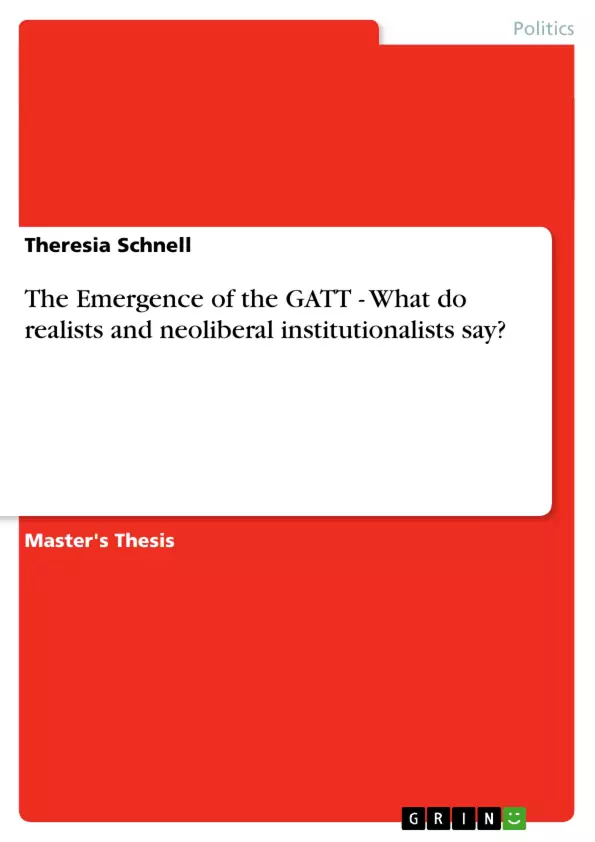Introduction
The emergence of the General Agreement on Tariffs and Trade (GATT) in 1947 marked a substantial turning point in the American trade policy from protectionism to free trade. High tariff barriers and the absence of free trade were seen as one of the main reasons for the Great Depression in the 1920s. To prevent such international economic crisis in the future the United States of America pushed forward negotiations about international economic cooperation that led to the GATT. Until today the imitation of the GATT, the WTO, is – together with the International Monetary Fund and the World Bank – the most important international economic cooperation.
Cooperation between states only comes into being if certain requirements are fulfilled. The different theories of international relations aim to explain under which circumstances such international cooperation emerges. Thereby each of these theories is based on different assumptions, i.e. about state behavior or the shape of the international system. The central research question of this paper is how good these assumptions of different theories fit the reality.
The objective is therefore to test if and how theories of international relations can explain the emergence of the GATT as an successful case of international cooperation. This will be done by concentrating on two different theories of international relations. The first one will be Neorealism and the second one Neoliberal Institutionalism.
In the first part the circumstances under which the GATT was created are briefly described. According to Neoliberal Institutionalists one of the main problems of inte rnational cooperation, cheating or free-riding, can be solved by international regimes. To understand if the GATT fits the requirements of an effective regime a definition of regime is given before the core assumptions of the two chosen theories are outlin ed. In the following second part the explanatory power of the two theories is tested by examining if the creation of the GATT fulfilled certain requirements of each theory. This will lead to the confrontation of the strength and weaknesses of each applied theory. It will be shown that the emergence of the GATT can be best explained by the Neorealistic Theory of Hegemonic Stability. The Neoliberal Institutionalism can explain why it was rational for several states to join the GATT but the theory fails in ex plaining who bears the costs of setting up the regime. [...]
Inhaltsverzeichnis (Table of Contents)
- Introduction
- Definitions
- Regime
- The emergence of the General Agreement on Tariffs and Trade (GATT)
- Neorealism
- Neoliberal Institutionalism
- How can Neorealism and Neoliberal Institutionalism explain the Emergence of GATT?
- Neorealism's approach
- Theory of Hegemonic Stability
- The United States of America – the hegemonic power after World War II.
- Incentives for other states to join the cooperation
- Neoliberal Institutionalism's approach
- The Problem of Cheating and Free-riding
- Exceptions
- The Problem of Cheating and Free-riding
- Neorealism's approach
- Strengths and Weaknesses of the applied theories
- Neorealism
- Neoliberal Institutionalism
Zielsetzung und Themenschwerpunkte (Objectives and Key Themes)
The objective of this paper is to investigate how effectively theories of international relations can explain the emergence of the General Agreement on Tariffs and Trade (GATT) as a successful case of international cooperation. This will be achieved by focusing on two prominent theories: Neorealism and Neoliberal Institutionalism.
- The emergence of GATT as a significant turning point in American trade policy.
- The role of international regimes in overcoming the challenges of international cooperation.
- The explanatory power of Neorealism and Neoliberal Institutionalism in understanding the creation of GATT.
- The strengths and weaknesses of each theoretical approach in explaining the emergence of GATT.
- The importance of hegemonic stability and the role of the United States in the establishment of GATT.
Zusammenfassung der Kapitel (Chapter Summaries)
The introduction outlines the significance of GATT as a turning point in American trade policy, shifting from protectionism to free trade. It also introduces the research question: how can theories of international relations explain the emergence of GATT?
The chapter on definitions elaborates on the concept of a regime, defining it as a structure that facilitates cooperation between states by establishing shared principles, norms, and rules. It also discusses the emergence of GATT and its three core principles.
The subsequent chapter examines how Neorealism and Neoliberal Institutionalism can explain the emergence of GATT. Neorealism's approach, particularly the Theory of Hegemonic Stability, emphasizes the role of the United States as a hegemonic power in driving the creation of GATT. Neoliberal Institutionalism focuses on the problem of cheating and free-riding and argues that international regimes can help address these challenges.
Finally, the chapter on strengths and weaknesses analyzes the effectiveness of each theory in explaining the emergence of GATT. It argues that Neorealism, specifically the Theory of Hegemonic Stability, provides a more comprehensive explanation than Neoliberal Institutionalism.
Schlüsselwörter (Keywords)
The central keywords and themes of this paper include: GATT, international cooperation, Neorealism, Neoliberal Institutionalism, hegemonic stability, international regimes, trade policy, free trade, protectionism, cheating, free-riding, and the United States of America.
- Quote paper
- Theresia Schnell (Author), 2004, The Emergence of the GATT - What do realists and neoliberal institutionalists say?, Munich, GRIN Verlag, https://www.grin.com/document/34008



